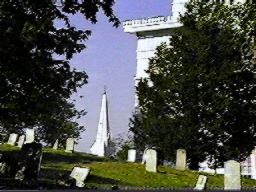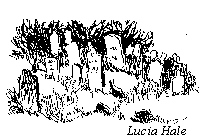 Old Burying Ground
Old Burying Ground
by Lois Beachy Underhill
 Old Burying Ground
Old Burying Ground
by Lois Beachy Underhill
It is after midnight on May 23, 1777. The British Redcoats are dug in on the high ground of Sag Harbor. A single shot is heard, coming from the direction of armed vessels in the harbor. The uneasy village residents wake up and listen for a second shot. At James Howell's Inn on Main Street, commandeered by British officers, Lieutenant Colonel Return Jonathan Meigs and his rebel raiders from Connecticut have just pulled the British commander from his bed and taken him prisoner. We know that at least two local men were among the raiders, John White, later a Deacon, whose account of the event was widely circulated, and Sergeant Elnathan Jennings, who served as Meigs' guide.
White reports that the shot "was not repeated, (because the British could not) determine the cause of the alarm." He continues laconically: "An outpost was immediately carried with fixed bayonets, and the land forces secured." Taking the enemy with silent, but deadly, "fixed bayonets" kept the operation sufficiently quiet that no further alarm was raised. The "outpost" White mentions was the British fort, an earthworks with palisades dug into the brow of the hill of the Old Burying Ground.
What White called "land forces" were the Redcoats of guard duty at the fort and those asleep in their barracks nearby. " Meigs and his men now held 6 enemy dead and 53 captured. The raiders "then proceeded to the shipping at the wharf," White says. At that point the ships in the harbor became aware of their peril. Meigs, though "being exposed to the fire from an armed schooner of 12 guns and 70 men for nearly an hour, completely effected the object of the expedition.
In a short time, 12 brigs and sloops, one of which carried 12 guns, were enveloped in flames -- and with them 120 tons of hay, 10 hogsheads of rum, and a large quantity of grain and merchandise were completely destroyed." The raiders took 37 additional prisoners at the wharf, for a total of 90, and returned to Connecticut.
Meigs' Expedition, as it came to be called, was the single glorious Revolutionary War encounter for the rebels on Long Island. (Alter a demoralizing defeat at the Battle of Long Island the previous year, the British had occupied the island. They would remain for 7 years.) General George Washington congratulated Meigs' superior officer writing give "my sincere thanks to Lieutenant Col. Meigs and all the officers and men."
The remains of the British earthworks fort are still here, George Finckenor, our village historian now retired, tells us. A mound running east to west diagonally across the top of the hill is believed to mark its location.
The hilltop had been Sag Harbor's burying ground for 10 years before this historic raid. In 1767 the Southampton town trustees had obtained the land, then heavily wooded with oaks, from Captain David Hand and built a picket fence around it. British forces, seeking the highest ground overlooking the harbor, ignored the graves. They cleared the trees and dug in, causing outrage among the relatives of the deceased and exacerbating the despair among the rebels. Almost half the families in Sag Harbor became refugees in Connecticut.
After 6 dreary years, the defeated British left in 1783, and the refugees returned The hill top became a burying ground once more. It was a "cedar hill" cemetery. typical of many of the time -- located on a hilltop unsuitable for farming, unlandscaped, a place where native eastern red cedars (juniperus virginiana) soon created a natural landscape.
Sag Harbor's founding citizens, among them men who had served in the Revolutionary War, were buried in the Old Burying Ground The earliest graves were sometimes marked with carved field stones. When the Hill brothers moved from Connecticut to Sag Harbor in 1793, Long Island acquired its first stone carvers. Elegant gravestones of sandstone imported from Connecticut and New Jersey became more easily available. Angel faces and weeping willows decorated the tops of the stones. About 1800, marble began replacing sandstone.
Oakland cemetery opened in 1840, designed in the newly fashionable land scaped park style. After that the Old Burying Ground was neglected. Even the completion of the magnificent Whaler's Church in 1844, immediately adjacent to the Old Burying Ground, did not revive interest in the site. The religious denominations of Sag Harbor established their own individual park style cemeteries, the A.M.E. Zion Church ca. 1840, St. Andrew's Roman Catholic Church in 1845, and the Jewish Synagogue in 1871. The Old Burying Ground which had once belonged to everybody now, apparently, belonged to no one.
By the mid 19th century herds of cattle and gangs of unruly boys roamed at will through the old graves, historian Dorothy Ingersoll Zaykowski tells us. A stone wall capped with granite had replaced the old picket fence. Part of the wall had been undermined, probably when Madison Street was graded and paved, and concerned citizens feared that caskets would tumble into the street with the spring rains. Eventually, in 1860, two dozen graves along Madison Street were moved to Oakland Cemetery. The Madison Street stone wall was torn down in 1863. A picket fence replaced it in 1880. After the Ladies Village Improvement Society was formed in 1887, the organization donated a handsome and long lasting iron fence for the Madison and Latham Street sides of the grounds. It still stands today, but shows the scars of its 10O year watch.
In 1902, the Sag Harbor Historical Society donated an impressive granite monument to the village to honor Lieutenant Colonel Meigs. Hill and Young, the successors of the Hill brothers, did the carving. The stone was placed below the Old Burying Ground and unveiled on May 23, 1902, the 125th anniversary of Meigs' dating raid. It stands beside Union Street, well tended by Jim Early and his men of the village Department of Public Works. The inscription reads: A BRITISH FORT NEAR THIS SPOT WAS CAPTURED BY THE AMERICANS UNDER LIEUT. COL. MEIGS AT THE BATTLE OF SAG HARBOR, MAY 23, 1777.
Those resting in the Old Burying Ground have not fared as well. In 1941, Louis T. Vail, the great, great, great grandson of Captain David Hand the original owner of the land, wrote to the Sag Harbor Express lamenting the neglect of the gravestones and the lack of recognition far the men who had served during the Revolutionary War. Captain William Havens' and other Revolutionary War graves had been cared for by the Southampton Daughters of the American Revolution for a time. Thanks to Paul Saurer, Havens' gravesite received a new commemorative plaque and dedication in 1993. His efforts have made us aware that we have neglected our old burying ground.
Its stones are deteriorated, many of them tumbled and broken. "Stones are living things, far more fragile than we assume," Dr. Gaynell Stone, the leeding authority on Long Island's colonial cemeteries tells me. She has photographed all the colonial cemeteries on Long Island from urban Brooklyn to the woods of Northwest, and she has seen the old stones in all seasons of the year. They freeze, they thaw, they exfoliate, they get eaten by lichens and they totally rebel against being set in concrete. Each stone requires individual treatment" Dr. Stone adds that there are experts available through the Association for Grave stone Studies in Greenfield, Massachusetts who can train volunteers to restore these historic markers.